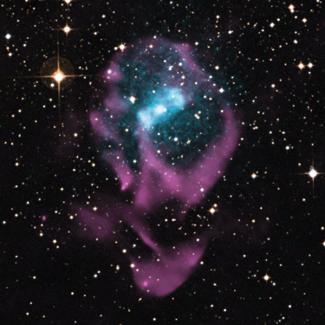Ever wondered how magnetic pressure alone might be able to maintain the structure of an accretion disk around a black hole in an x-ray binary system? Fellow Mitch Begelman recently gave the idea a lot of thought. And, in the process of working on the idea with Fellow Phil Armitage and Chris Reynolds of the University of Maryland, Begelman came up with a new model for accretion disks around black holes in x-ray binary systems, such as the one shown in the picture.
The new model shows how twisted magnetic-field oscillations can maintain accretion disk structures via dynamo action. In fact, magnetic dynamos are able to maintain large-scale magnetic fields and the matter they contain over astronomical time scales. Thus the new model also explains (1) how observed spectral changes in the x-ray region of binary accretion disks are associated with two different disk states and (2) why these accretion disks do not appear to be inherently unstable.
Here’s what the new model suggests is happening: The magnetic field in an accretion disk behaves like a rubber band. There’s a kind of a stretching effect where the disk transfers spin, or angular momentum, from close to the black hole to farther out. This transfer is important because it allows the close-in matter to fall into the black hole, something it wouldn’t be able to do if the disk always spun rapidly.
When the spin-transfer process begins, things appear to become powerfully unstable, and the gas actively jerks around, becoming turbulent and chaotic. This is when things get complicated because it turns out that the magnetic field isn’t completely chaotic. Astrophysicists have known for a long time that the turbulence has a tendency to spontaneously self-organize. Various loops of magnetic field start to reinforce neighboring loops, causing them to get really strong in either a clockwise or counterclockwise direction. Initially, both directions have equal probabilities, but once the amplification process starts it all clicks into a single direction.
What happens (over and over) is that the magnetic field spontaneously goes in one direction and then pivots and goes in the other direction. This periodic reversal of the magnetic field is a signature of a magnetic dynamo [1]. And, since the entire disk becomes dominated by a reversing, twisted magnetic field, the dynamo is able maintain the structure of the accretion disk.
However, any time there is a strong magnetic field in the accretion disk orbiting a black hole, the field “wants” to escape vertically. But, the gas attached to the field acts to keep the magnetic field in place. Even so, there’s a tendency for the magnetic field to buckle even if it’s lying flat with gas pressing down on it.
It turns out that random fluctuations in the magnetic field can cause a little piece of the field to buckle, and the buckle can grow and grow until the magnetic field just bubbles away. Of course, at the same time the old field is disappearing, a new magnetic field is being recreated during on-going transfers of spin to the outer regions of the accretion disk.
Begelman discovered that the production of the magnetic field and its escape are in equilibrium. And, with his new model, it’s possible to calculate the strength of the magnetic field at various heights of the disk and figure out the degree to which the escaping field is heating up the gas at different heights.
Interestingly, the twisted magnetic field also gives rise to the x-ray spectral changes characteristic of a black hole in an x-ray binary system. When dense gas (often near the disk center) is heated, what appears is an x-ray spectrum dominated by soft, or longer-wavelength, x-rays. In contrast, when much less dense gas (high up in the disk) is heated, the x-ray spectrum is dominated by hard, or shorter-wavelength, x-ray photons. The disk cyclically transitions between being primarily in one or the other of these two states.
One factor affecting this cyclic process is the flow of mass coming into the disk from the black hole’s companion star. As a wave of matter comes in, it thickens the inner region of the disk, dragging in more vertical magnetic field. This process tends to enhance the dynamo effect and heats gas very high up in the disk, producing hard x-rays.
If the accretion disk gets too thick, the central part of the disk collapses because of too much cooling. Consequently, it drags in less magnetic field, weakening the dynamo. The flow of mass into the disk ebbs. But, as soon as the disk can no longer radiate energy, it begins to thicken again. The thicker disk starts collecting more magnetic field, and the cycle begins anew.
If Begelman’s new model stands the test of time, it will be a paradigm shift in the way astrophysicists understand the behavior of x-ray binary accretion disks.—Julie Phillips
[1] A similar process occurs in the Sun and is responsible for the 11-year solar cycle.




